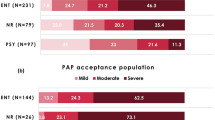Abstract
Purpose
Split-night polysomnography (SN-PSG) provides both a diagnosis and titration of continuous positive airway pressure over a single night in patients with suspected obstructive sleep apnea (OSA). However, in Asian patients, the diagnostic validity of American Academy of Sleep Medicine (AASM) guidelines for SN-PSG remains uncertain. Therefore, we examined whether the current criteria for SN-PSG are pertinent for Asian patients.
Method
We investigated 134 consecutive patients who were diagnosed with OSA (apnea-hypopnea index (AHI) ≥ 5). We divided the raw data (full-night study) into two parts and compared the first 2 h of sleep with the full night of sleep to evaluate the diagnostic precision and accuracy of the first 2 h of sleep.
Results
No difference in AHI was observed between the first 2 h and the full night of sleep. A significant correlation of AHI was observed between the first 2 h and the full night of sleep for severe OSA patients (AHI ≥ 30). A correlation coefficient of AHI was higher by the criterion of AHI ≥ 30 than by the criterion of AHI ≥ 40 (r = 0.831 and r = 0.778, respectively), which is the current AASM criterion for SN-PSG. Moreover, the criterion AHI ≥ 30 showed better diagnostic accuracy than the criterion AHI ≥ 40 (89.3 and 88.7 %, respectively).
Conclusions
This study found possible evidence supporting different diagnostic criteria for SN-PSG in Asian population. We suggest further studies in other Asian populations to confirm these findings.

Similar content being viewed by others
References
Epstein LJ, Kristo D, Strollo PJ Jr, Friedman N, Malhotra A, Patil SP, Ramar K, Rogers R, Schwab RJ, Weaver EM, Weinstein MD, Adult Obstructive Sleep Apnea Task Force of the American Academy of Sleep Medicine (2009) Clinical guideline for the evaluation, management and long-term care of obstructive sleep apnea in adults. J Clin Sleep Med 5(3):263–276
Berry RB, Budhiraja R, Gottlieb DJ, Gozal D, Iber C, Kapur VK, Marcus CL, Mehra R, Parthasarathy S, Quan SF, Redline S, Strohl KP, Davidson Ward SL, Tangredi MM, American Academy of Sleep Medicine (2012) Rules for scoring respiratory events in sleep: update of the 2007 AASM manual for the scoring of sleep and associated events. Deliberations of the sleep apnea definitions task force of the American Academy of sleep medicine. J Clin Sleep Med 8(5):597–619
Deutsch PA, Simmons MS, Wallace JM (2006) Cost-effectiveness of split-night polysomnography and home studies in the evaluation of obstructive sleep apnea syndrome. J Clin Sleep Med 2(2):145–153
Rodway GW, Sanders MH (2003) The efficacy of split-night sleep studies. Sleep Med Rev 7(5):391–401
Patel NP, Ahmed M, Rosen I (2007) Split-night polysomnography. Chest 132(5):1664–1671
Collen J, Holley A, Lettieri C, Shah A, Roop S (2010) The impact of split-night versus traditional sleep studies on CPAP compliance. Sleep Breath 14(2):93–99
Lim YH, Choi J, Kim KR, Shin J, Hwang KG, Ryu S, Cho SH (2014) Sex-specific characteristics of anthropometry in patients with obstructive sleep apnea: neck circumference and waist-hip ratio. Ann Otol Rhinol Laryngol 123(7):517–523
Liu Y, Lowe AA, Zeng X, Fu M, Fleetham JA (2000) Cephalometric comparisons between Chinese and Caucasian patients with obstructive sleep apnea. Am J Orthod Dentofacial Orthop 117(4):479–485
Li KK, Kushida C, Powell NB, Riley RW, Guilleminault C (2000) Obstructive sleep apnea syndrome: a comparison between Far-East Asian and white men. Laryngoscope 110(10 Pt 1):1689–1693
Lam B, Ooi CG, Peh WC, Lauder I, Tsang KW, Lam WK, Ip MS (2004) Computed tomographic evaluation of the role of craniofacial and upper airway morphology in obstructive sleep apnea in Chinese. Respir Med 98(4):301–307
Chirakalwasan N, Teerapraipruk B, Simon R, Hirunwiwatkul P, Jaimchariyatam N, Desudchit T, Charakorn N, Wanlapakorn C (2013) Comparison of polysomnographic and clinical presentations and predictors for cardiovascular-related diseases between non-obese and obese obstructive sleep apnea among Asians. J Clin Sleep Med 9(6):553–557
Chou KT, Chang YT, Chen YM, Su KC, Perng DW, Chang SC, Shiao GM (2011) The minimum period of polysomnography required to confirm a diagnosis of severe obstructive sleep apnoea. Respirology 16(7):1096–1102
Charbonneau M, Marin JM, Olha A, Kimoff RJ, Levy RD, Cosio MG (1994) Changes in obstructive sleep apnea characteristics through the night. Chest 106(6):1695–1701
Sanders MH, Black J, Costantino JP, Kern N, Studnicki K, Coates J (1991) Diagnosis of sleep-disordered breathing by half-night polysomnography. Am Rev Respir Dis 144(6):1256–1261
Scharf SM, Garshick E, Brown R, Tishler PV, Tosteson T, McCarley R (1990) Screening for subclinical sleep-disordered breathing. Sleep 13(4):344–353
Iber C, O’Brien C, Schluter J, Davies S, Leatherman J, Mahowald M (1991) Single night studies in obstructive sleep apnea. Sleep 14(5):383–385
Yamashiro Y, Kryger MH (1995) CPAP titration for sleep apnea using a split-night protocol. Chest 107(1):62–66
Khawaja IS, Olson EJ, van der Walt C, Bukartyk J, Somers V, Dierkhising R, Morgenthaler TI (2010) Diagnostic accuracy of split-night polysomnograms. J Clin Sleep Med 6(4):357–362
Acknowledgments
The authors wish to acknowledge residents from Hanyang University Hospital for their assistance as study coordinators for the patients involved in this study.
Conflict of interest
This was not an industry-supported study. No potential conflict of interests relevant to this article was reported.
Author information
Authors and Affiliations
Corresponding author
Rights and permissions
About this article
Cite this article
Kim, DK., Choi, J., Kim, K.R. et al. Rethinking AASM guideline for split-night polysomnography in Asian patients with obstructive sleep apnea. Sleep Breath 19, 1273–1277 (2015). https://doi.org/10.1007/s11325-015-1158-2
Received:
Revised:
Accepted:
Published:
Issue Date:
DOI: https://doi.org/10.1007/s11325-015-1158-2




